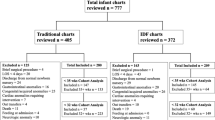Abstract
OBJECTIVE: To ascertain whether the implementation of a paced feeding protocol in a sample of preterm infants with respiratory diagnoses will result in the development of more efficient sucking patterns, increased weight gain, decreased incidence of bradycardia during feeding, and shorter length of hospital stay.
METHOD: A total of 36 premature infants were enrolled into a nonrandomized clinical trial conducted in a neonatal intensive care unit (NICU). The first 18 infants were traditionally bottle-fed. Following this cohort's discharge from NICU, nursing staff completed continuing education on implementing a paced feeding protocol and the next 18 infants were delivered paced feedings.
RESULTS: The two cohorts were equivalent at the initiation of oral feedings on gestational age, birth weight, 1 and 5 minute Apgar scores, weight, and postconceptual age. The paced infants demonstrated statistically and clinically significant decreases in bradycardic incidences during feeding and gains in development of more efficient sucking patterns at discharge. Discharge and average weekly weight gain did not differ between the two groups.
CONCLUSIONS: The incorporation of pacing into NICU care practices appears to be beneficial for preterm infants with respiratory disease.
This is a preview of subscription content, access via your institution
Access options
Subscribe to this journal
Receive 12 print issues and online access
$259.00 per year
only $21.58 per issue
Buy this article
- Purchase on Springer Link
- Instant access to full article PDF
Prices may be subject to local taxes which are calculated during checkout

Similar content being viewed by others
References
Braun MA, Palmer MM . A pilot study of oral-motor dysfunction in “at-risk” infants. Phys Occup Ther Pediatr 1985/1986;5:13–25.
Casaer P, Daniels H, Devlieger H, DeCock P, Eggermont E . Feeding behaviour in pre-term neonates. Early Hum Dev 1982;7:331–346.
Glass RP, Wolf LS . A global perspective on feeding assessment in the neonatal intensive care unit. Am J Occup Ther 1994;48:514–526.
Hunter J, Mullen J, Dallas DV . Medical considerations and practice guidelines for the neonatal occupational therapist. Am J Occup Ther 1994;48:546–560.
Rosen CL, Glaze DG, Frost JD . Hypoxemia associated with feeding in the preterm infant and full-term neonate. Am J Dis Child 1984;138:623–628.
Guilleminault C, Coons S . Apnea and bradycardia during feeding in infants weighing >2000 gm. J Pediatr 1984;104:932–935.
Palmer MM . Identification and management of the transitional suck pattern in premature infants. J Perinat Neonatal Nurs 1993;7(1):66–75.
Hill AS, Kurkowski TB, Garcia J . Oral support measures used in feeding the preterm infant. Nurs Res 2000;49(1):2–10.
Bu'Lock F, Woolridge MW, Baum JD . Development of co-ordination of sucking, swallowing and breathing: ultrasound study of term and preterm infants. Dev Med Child Neurol 1990;32:669–678.
Gryboski, J . Suck and swallow in the premature infant. Pediatrics 1969;43:96–102.
Weber F, Woolridge MW, Baum JD . An ultrasonographic study of the organisation of sucking and swallowing by newborn infants. Dev Med Child Neurol 1986;28:19–24.
Medoff-Cooper B, Verklan T, Carlson S . The development of sucking patterns and physiologic correlates in very-low-birth-weight infants. Nurs Res 1993;42(2):100–105.
Medoff-Cooper B, Weininger S, Zukowsky K . Neonatal sucking as a clinical assessment tool: preliminary findings. Nurs Res 1989;38(3):162–165.
Als H, Lawhon G, Brown E, Gibes R, Duffy FH, McAnulty G, Blickman JG . Individualized behavioral and environmental care for the very low birth weight preterm infant at high risk for bronchopulmonary dysplasia: neonatal intensive care unit and developmental outcome. Pediatrics 1986;78:1123–1132.
Van den Berg KA . Nippling management of the sick neonate in the NICU: the disorganized feeder. Neonat Network 1990;9:9–16.
Case-Smith J . An efficacy study of occupational therapy with high-risk neonates. Am J Occup Ther 1988;42:499–506.
Case-Smith J, Cooper P, Scala V . Feeding efficiency of premature neonates. Am J Occup Ther 1989;43:245–250.
Palmer MM, Crawley K, Blanco IA . Neonatal Oral-Motor Assessment Scale: a reliability study. J Perinatol 1993;13(1):28–35.
Anderson GC, Vidyasagar D . Development of sucking in premature infants from 1 to 7 days post-birth. Birth Defects 1979;15:145–171.
Mathew OP . Respiratory control during nipple feeding in preterm infants. Pediatr Pulmonol 1988;5:220–224.
Bernbaum JC, Pereira GF, Watkins JB, Peckham GJ . Nonnutritive sucking during gavage feeding enhances growth and maturation in premature infants. Pediatrics 1983;71:41–45.
Hawdon JM, Beauregard N, Slattery J, Kennedy G . Identification of neonates at risk of developing feeding problems in infancy. Dev Med Child Neurol 2000;42:235–239.
Acknowledgements
We gratefully acknowledge the Intramural Small Grants Program, LSUHSC School of Allied Health Professions for providing financial support for this study.
Author information
Authors and Affiliations
Rights and permissions
About this article
Cite this article
Law-Morstatt, L., Judd, D., Snyder, P. et al. Pacing as a Treatment Technique for Transitional Sucking Patterns. J Perinatol 23, 483–488 (2003). https://doi.org/10.1038/sj.jp.7210976
Published:
Issue Date:
DOI: https://doi.org/10.1038/sj.jp.7210976


